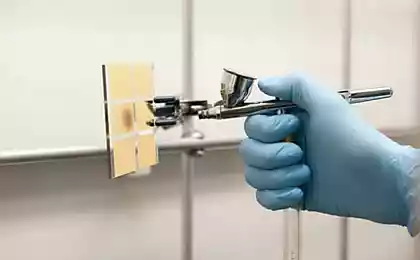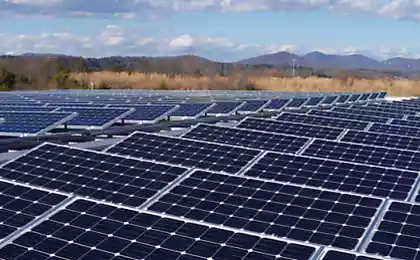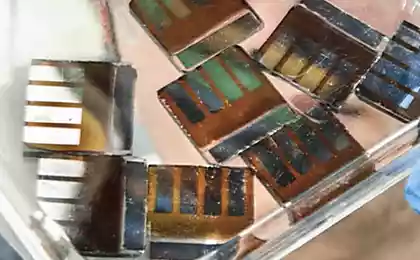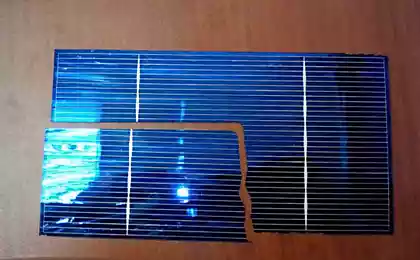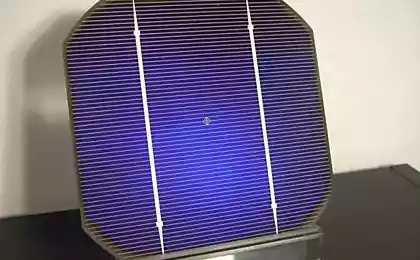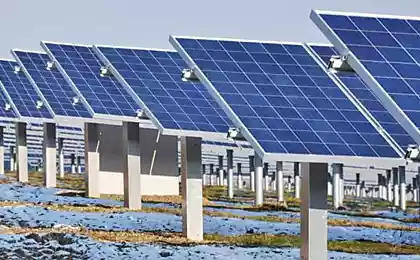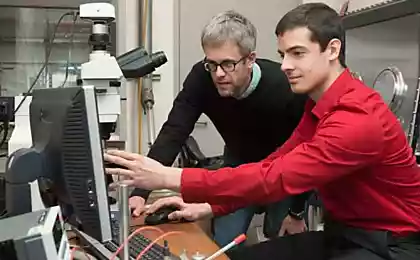520
New material may replace silicon, doubling the efficiency of solar cells
Researchers have shown that in solar cells based perovskites, the charge carriers having excess energy that can travel considerable distances before it dissipates as heat. This means that to implement the photovoltaic cells for hot media, for which the theoretical limit of efficiency is twice higher than that of conventional silicon, in practice it is possible. A study published in the journal Science.
Sixty six million four hundred sixty three thousand three hundred fifteen
The most prevalent solar cells, used as semiconductor silicon, it is theoretically possible efficiency barely exceeds 30 percent.
This is because the silicon cells are able to use sunlight spectrum only partially. Photons with energy below the threshold is simply not absorbed, and having a too high lead to the formation of the solar cell so-called hot charge carriers (e.g., electrons). The life time is about one picosecond (10-12 seconds), then they "cool down", that is, dissipate excess energy as heat. If hot carriers were able to collect, this would increase the theoretical limit efficiency of up to 66 percent, that is double. Despite the fact that in some experiments a small conservation of energy was able to observe the elements on hot carriers are still rather hypothetical.
Scientists from Purdue University and the National renewable energy laboratory (USA) has made a contribution to the study of a new promising class of photovoltaic cells based on perovskites and showed that the elements of hot carriers not only have an increased life time (up to 100 picoseconds), but is able to "run" significant distance of a few hundred nanometers (comparable to the thickness of the semiconductor layer).
ORGANOMETALLIC perovskites got its name from its crystal structure. It essentially follows the structure of the natural mineral perovskite, or calcium titanate. Chemically, they constitute a mixed halides of lead and organic cations. The authors used the common perovskite-based lead iodide and methylamine. Based on the fact that in perovskites the lifetime of hot carriers is significantly increased in comparison with other semiconductors, the authors decided to find out at what distance you can transfer the hot carriers during their cooling. Using ultra speed microscopy, the researchers were able to directly observe the transport of hot carriers in thin films of perovskite with high spatial and temporal resolution.
Seventy nine million six hundred forty three thousand nine hundred ninety five
Transport of hot carriers in a semiconductor within the first picosecond after excitation
It turned out that the slow cooling in perovskites associated with the range, which amounted to 600 nanometers. This means that the charge carriers with excess energy is theoretically able to overcome the semiconductor layer and reach the electrode, that is, it is possible to collect (though this is technically feasible, the authors do not discuss). Thus, the solar cells on hot carriers may be able to implement, based perovskites.
Forty one million five hundred seventy nine thousand two hundred twenty seven
To date, maximum efficiency, reaching 46%, was recorded for the multicomponent multilayer photovoltaic cells, including gallium arsenide, indium, germanium with phosphorus inclusions. Such semiconductors use light more efficiently by absorbing different parts of the spectrum. Their production is very expensive, so these items are only used in the aerospace industry. Previously we also wrote about cells based on cadmium telluride, which can be produced in the form of a flexible and thin films. Despite the fact that the overall contribution to the electricity production of solar energy does not exceed 1%, the rate of growth can be called explosive. Particularly interested in the use of renewable solar energy to countries such as India and China. Google in the end of 2016, said that this year is going to completely switch to renewable energy.
Currently in everyday life are mainly silicon solar cells, the actual efficiency is 10-20 percent. Cells based on perovskites emerged less than 10 years ago and immediately summoned the deserved interest. The efficiency of such elements increases rapidly and almost brought to 25 percent, which is comparable with the best silicon cells. In addition, they are very simple to manufacture. Despite technological success, the physical principles of perovskite elements are relatively little studied, so discussing the work of scientists from the United States makes an important contribution to the fundamental basis of photovoltaics and, of course, entails the prospect of further increase the efficiency of solar cells. published
P. S. And remember, only by changing their consumption — together we change the world! ©
Source: //phys.org/news/2017-04-crystalline-material-silicon-efficiency-solar.html
Sixty six million four hundred sixty three thousand three hundred fifteen
The most prevalent solar cells, used as semiconductor silicon, it is theoretically possible efficiency barely exceeds 30 percent.
This is because the silicon cells are able to use sunlight spectrum only partially. Photons with energy below the threshold is simply not absorbed, and having a too high lead to the formation of the solar cell so-called hot charge carriers (e.g., electrons). The life time is about one picosecond (10-12 seconds), then they "cool down", that is, dissipate excess energy as heat. If hot carriers were able to collect, this would increase the theoretical limit efficiency of up to 66 percent, that is double. Despite the fact that in some experiments a small conservation of energy was able to observe the elements on hot carriers are still rather hypothetical.
Scientists from Purdue University and the National renewable energy laboratory (USA) has made a contribution to the study of a new promising class of photovoltaic cells based on perovskites and showed that the elements of hot carriers not only have an increased life time (up to 100 picoseconds), but is able to "run" significant distance of a few hundred nanometers (comparable to the thickness of the semiconductor layer).
ORGANOMETALLIC perovskites got its name from its crystal structure. It essentially follows the structure of the natural mineral perovskite, or calcium titanate. Chemically, they constitute a mixed halides of lead and organic cations. The authors used the common perovskite-based lead iodide and methylamine. Based on the fact that in perovskites the lifetime of hot carriers is significantly increased in comparison with other semiconductors, the authors decided to find out at what distance you can transfer the hot carriers during their cooling. Using ultra speed microscopy, the researchers were able to directly observe the transport of hot carriers in thin films of perovskite with high spatial and temporal resolution.
Seventy nine million six hundred forty three thousand nine hundred ninety five
Transport of hot carriers in a semiconductor within the first picosecond after excitation
It turned out that the slow cooling in perovskites associated with the range, which amounted to 600 nanometers. This means that the charge carriers with excess energy is theoretically able to overcome the semiconductor layer and reach the electrode, that is, it is possible to collect (though this is technically feasible, the authors do not discuss). Thus, the solar cells on hot carriers may be able to implement, based perovskites.
Forty one million five hundred seventy nine thousand two hundred twenty seven
To date, maximum efficiency, reaching 46%, was recorded for the multicomponent multilayer photovoltaic cells, including gallium arsenide, indium, germanium with phosphorus inclusions. Such semiconductors use light more efficiently by absorbing different parts of the spectrum. Their production is very expensive, so these items are only used in the aerospace industry. Previously we also wrote about cells based on cadmium telluride, which can be produced in the form of a flexible and thin films. Despite the fact that the overall contribution to the electricity production of solar energy does not exceed 1%, the rate of growth can be called explosive. Particularly interested in the use of renewable solar energy to countries such as India and China. Google in the end of 2016, said that this year is going to completely switch to renewable energy.
Currently in everyday life are mainly silicon solar cells, the actual efficiency is 10-20 percent. Cells based on perovskites emerged less than 10 years ago and immediately summoned the deserved interest. The efficiency of such elements increases rapidly and almost brought to 25 percent, which is comparable with the best silicon cells. In addition, they are very simple to manufacture. Despite technological success, the physical principles of perovskite elements are relatively little studied, so discussing the work of scientists from the United States makes an important contribution to the fundamental basis of photovoltaics and, of course, entails the prospect of further increase the efficiency of solar cells. published
P. S. And remember, only by changing their consumption — together we change the world! ©
Source: //phys.org/news/2017-04-crystalline-material-silicon-efficiency-solar.html
U-Boat Worx continues to conquer the seas and oceans with Li-Ion battery
Honda unveiled the electric Clarity Electric Clarity hybrid and Plug-in Hybrid




